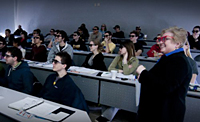Faculty, ITaP partnership looks at making 3-D projection a classroom staple
Faculty, ITaP partnership looks at making 3-D projection a classroom staple
| Magazine Section: | Innovate |
|---|---|
| College or School: | CoE |
| Article Type: | Article |
She has used diagrams and 2-D animations. She has stood in front of the class rotating a book in the air with her hands. Yet her students, even when they understand the math, often have a difficult time grasping the concepts behind the calculations.
"You can produce a string of numbers that are all correct and you still have no idea what it means," Howell says.
Now, a classroom with 3-D stereoscopic projection capability resulting from collaboration between faculty members and ITaP is making it easier for Howell's students to grasp the meaning behind the numbers.
Cognitive psychology research suggests that immersive 3-D stereoscopic graphics can enhance teaching, learning and retention, particularly in science, technology, engineering and math (STEM). The technology can be especially useful for understanding concepts that involve scale, relative size, relative position and location of objects, and perspective. But its use thus far has been limited almost entirely to specialized settings rather than typical classrooms.

Gary Bertoline, Distinguished Professor of Computer Graphics Technology and founding director of ITaP's Envision Center for Data Perceptualization, and Laura Cayon, research associate professor of physics, worked together to win a Purdue Provost's Office grant for improving classroom technology with a pilot project adding 3-D stereoscopic projection in a regular classroom. Howell, who has collaborated with the Envision Center on visualizing her research, also joined in the effort.
They worked with the Envision Center, ITaP's visualization facility, and ITaP audio-visual services to equip an otherwise normal classroom in Neil Armstrong Hall of Engineering with a 3-D projector and screen as well as stereoscopic glasses, similar to those one might wear watching a 3-D movie like "Avatar." The Envision Center also helps in creating course materials designed for the environment with software for building 3-D content and staff and students adept at using it.
An understanding of 3-D rotation is integral to communicating with, aiming and controlling spacecraft, as well as modeling the processes, Howell says. It can mean the difference between putting an object in orbit around a planet, crashing it into the surface, or sending it careening off into the void.
In engineering generally, three-dimensional thinking and 3-D rotation are among the most difficult concepts to teach and learn. But they can be taught, and Purdue's 3-D stereoscopic classroom appears to help.
Howell and her graduate student assistants can not only rotate a virtual rendition of the real-life book she's used in class previously, but change key parameters precisely to show, rather than simply discuss, the effects of doing so. Or, they can do the same thing with a rendering of a satellite orbiting Earth, all in real time. The results with her students so far have sold her.
"They understand what the motion is and they understand it a lot more quickly," Howell says. "During the times when I am using it they're more engaged. They're more excited about the topic. These are the tools we'll all use in the future. We're trying to mainstream it."
Cayon likewise is sold. Cayon, graduate students from the College of Technology, and physics and engineering undergraduate students have built 3-D stereoscopic models of our solar system placed in the context of the Milky Way galaxy and the Milky Way's 30 nearest galaxy neighbors, members of the so-called Local Group. Next up: hundreds of galaxies in the neighboring Virgo cluster -- if you define the neighborhood as taking in roughly 60 million light-years.
The models, in essence, take students on a trip through the solar system and beyond, giving them a better sense of "how big things are and how distant they are from one another," Cayon says. "You can see how tiny our solar system is within our galaxy."
The model galaxies also can be rotated, the better to convey their shapes. "Being interactive to me makes a big difference between this and running a movie," Cayon says.
Bertoline says the professors are working on funding to modify the system in 2011 based on lessons learned in the pilot, which began in 2010. The goal: develop a tested, cost-effective template for adding the technology to Purdue classrooms whenever they're slated for technology upgrades.
More in-depth study of how 3-D stereoscopic technology can enhance learning and be optimized for that purpose also is planned along with further curriculum development, including interactive course materials that could allow students to work on their own in labs equipped with 3-D computer monitors coming on the market.
Comments